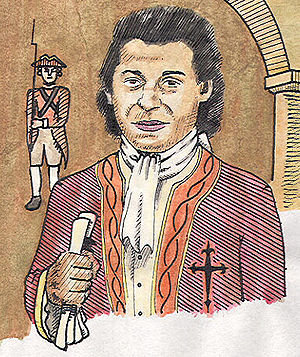
Juan del Valle y Caviedes
Encyclopedia

Baroque
The Baroque is a period and the style that used exaggerated motion and clear, easily interpreted detail to produce drama, tension, exuberance, and grandeur in sculpture, painting, literature, dance, and music...
Colonial period, and shares much with Baroque writers such as Mateo Rosas de Oquendo, Sor Juana
Sor Juana
Sor Juana Inés de la Cruz , fully Juana Inés de Asbaje y Ramírez de Santillana, was a self-taught scholar and poet of the Baroque school, and nun of New Spain...
and Bernardo de Balbuena
Bernardo de Balbuena
Bernardo de Balbuena was a Spanish poet. He was the first of a long series of Latin American poets who extolled the special beauties of the New World.- Life :...
. He is a sharp social and political critic, pointing out the shortcomings and hypocrisies of the traditional and smug Spanish American colonial administrators.
Caviedes was born in Porcuna
Porcuna
Porcuna is a village and municipality in the province of Jaén in Andalusia, Spain, 42 km from Jaén and 50 km from Córdoba. The primary occupation of the 6,990 inhabitants is olive growing...
, Andalucía, Spain in 1645. He came to Peru
Peru
Peru , officially the Republic of Peru , is a country in western South America. It is bordered on the north by Ecuador and Colombia, on the east by Brazil, on the southeast by Bolivia, on the south by Chile, and on the west by the Pacific Ocean....
at an early age and settled in Lima, later spending some time in the mining area of Huancavelica
Huancavelica
Huancavelica is a city in Peru. It is the capital of the Huancavelica region and has a population of approximately 40,000. Indigenous peoples represent a major percentage of the population. It has an approximate altitude of 3,600 meters; the climate is cold and dry between the months of February...
, where life was hard even for a Spaniard at the top of the social pyramid. As has been shown by various critics, a false biography based on the author's satirical works suggested that he dissipated his fortune on gambling, drink, and women of dubious morals and that as a result of having contracted a venereal disease he directed his satirical bite at the damage done by physicians and their indifferent and rapacious attitude toward their patients. Much to the contrary, however, in his satire of doctors and medicine Caviedes is actually following a long-standing satirical Western tradition.
Work
As a writer Caviedes shares many characteristics with several of the writers of Spanish Golden AgeSpanish Golden Age
The Spanish Golden Age is a period of flourishing in arts and literature in Spain, coinciding with the political rise and decline of the Spanish Habsburg dynasty. El Siglo de Oro does not imply precise dates and is usually considered to have lasted longer than an actual century...
, such as Francisco de Quevedo
Francisco de Quevedo
Francisco Gómez de Quevedo y Santibáñez Villegas was a Spanish nobleman, politician and writer of the Baroque era. Along with his lifelong rival, Luis de Góngora, Quevedo was one of the most prominent Spanish poets of the age. His style is characterized by what was called conceptismo...
and Luis de Góngora
Luis de Góngora
Luis de Góngora y Argote was a Spanish Baroque lyric poet. Góngora and his lifelong rival, Francisco de Quevedo, are widely considered to be the most prominent Spanish poets of their age. His style is characterized by what was called culteranismo, also known as Gongorism...
, partially because of his satirical, biting, vulgar, popular, and picaresque wit. But behind this criticism is a sharp social and moral attack on the abuses, injustices, and double standards of the Colonial period. He is also the author of serious love and religious poetry.
When Caviedes moved to Lima the targets of his biting satire included not only doctors, but also Lima aristocrats and even the Viceregal court. Following satirical tradition, he attacked many professions, among them lawyers, tailors, and street women, with an emphasis on the grotesque, the scatological, the ugly, and the immoral. With some exceptions, the scandalous aspects of his work made publication difficult during his lifetime, but his works circulated in handwritten chapbooks and were collected in various manuscripts. There are several modern editions of his complete works.
"Colloquium that a seriously ill doctor had with Death"
-
- From: Diente del Parnaso/ Tooth of Parnassus, Translated by Jack Child
Take care that in your eagerness
if you treat doctors this way
you'll force the priests and sacristans
to go on all fours.
Because neither sunstroke nor excess
or the worst parents-in-law
fruit or snow without liquor,
bullet, stockade or song
kill in one year as many
as the best doctor.

